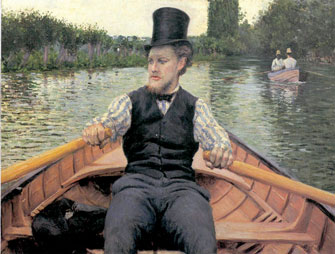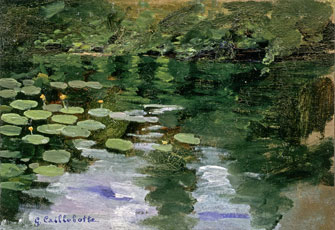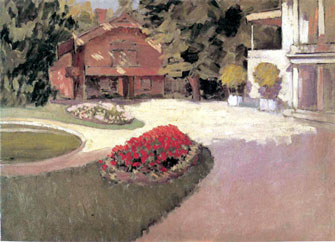At Home in the
Country with Caillebotte

Gustave Caillebotte’s “Rower in a Top Hat” (1875-78). Courtesy of the Comité Caillebotte, Paris
Gustave Caillebotte may be best known for his iconic views of Paris – think of “Paris Street, Rainy Day” (1877), with its elegant ladies and gentlemen sheltered by black umbrellas promenading on rain-slicked cobblestones in front of a typical Haussmannian apartment building – but when the sun comes out in his nature paintings, they inspire an urgent desire to escape the cobblestoned streets and get out into the countryside.
Luckily, it is perfectly possible to do just that while following in Caillebotte’s own footsteps. The garden of the house in Yerres, near Paris, where the artist grew up and which he used as his country home for much of his adult life, has been open to the public for some time, but now the house is being restored, and this summer a sparkling exhibition of 43 important paintings by the artist, most of them made on the estate, is on show there.
Along with a picture of a horse painted in the very stables where the exhibition is being held are images of his family and friends canoeing on the Yerres River, which flows past the park outside; an unfinished painting of a man playing billiards in the house; and views of the park, including the beautifully melancholy “Yerres, Effet de Pluie (1875)” – rainy days

“Yerres, sur l’Etang: Nymphéas” (before 1879). Courtesy of the Comité Caillebotte, Paris
held their attraction, even in the country – and water lilies on the pond in “Yerres, sur l’Etang: Nymphéas” (before 1879).
For good measure, a couple of Paris scenes are thrown in, including “Boulevard, Vu d’en Haut” (1880), a revolutionary view of the street from above that shows the influence of photography on the artist’s work. This picture in turn influenced photographers for decades to come: an image taken of the Avenue de l’Opéra from above by André Kertesz in 1929, for example, is so close to Caillebotte’s painting that it amounts to Jeff Koons-style “appropriation.”
Caillebotte is considered an Impressionist, but the exhibition’s curator, Serge Lemoine, former director of the Musée d’Orsay, who gave a tour of the show the other day, explained that the artist had been forgotten for many years, in part because he was considered a dilettante (he was mocked, for example, for his “elitist” painting “Rower in a Top Hat,” 1877-78, pictured above) and in part because his work is often difficult to classify. Even though he is decidedly an Impressionist, “he created something completely new that doesn’t fit easily into the history of art,” said Lemoine. Pointing to “Prairie à Yerres” (1875), a painting of a cow and a tree in a field, he added, “If this is an Impressionist painting, then I had better change professions.” He sees other works, such as the boy in blue in the pastel “Camille Daurelle dans le Jardin d’Yerres” (1877) as closer to the work of Symbolists like Odilon Redon. As for the rower in the top hat, Lemoine imagines a man arriving from the city so anxious to get out on the water that he doesn’t take the time to change his clothes, just stripping off his jacket and throwing it into the boat beside him.
For Lemoine, Caillebotte was a iconoclastic modernist comparable to Manet in the way he rejected academic heroism and instead depicted ordinary people doing ordinary things like swimming, fishing, boating, strolling in the streets, etc. and took on subjects like bridges and rail stations that would never before have been considered appropriate to the world of art. He broke other rules by distorting perspective, showing people from the back and framing his compositions in new ways.
Born to a wealthy family, Caillebotte did not have to work and instead filled his time by obsessively pursuing many activities besides painting, taking full advantage of the gifts and privileges that had been showered upon him. He was an avid gardener and horticulturist, and a collector of stamps and paintings (he left to the French state a collection of paintings by the great Impressionists), as well as a boating enthusiast. He eventually sold the property at Yerres because he had taken up sailing, which wasn’t possible on the small local river he loved to row on. Not content with the sailboats he was able to buy, this determined and energetic man went so far as to design his own.
After seeing the show, visitors can wander around the lovely park, with its many charming outbuildings, and along the banks of the Yerres River, where canoes can be rented. Most interesting of the outbuildings is the icehouse, basically a big hole in the ground under a building where ice was made in the winter in the days before refrigeration. Covered with straw, it would last through the summer. You can still feel the chill when you walk into the building and peer down into the hole. The “Swiss chalet” houses a fine restaurant, Le Chalet du Parc (a reservation would probably be wise: 01 69 06 86 29). The first floor of the family’s elegant Palladian-style

“Jardin à Yerres” 1876. Courtesy of the Comité Caillebotte, Paris.
house can now be visited, and the potager (vegetable garden) is open on Sunday afternoons.
Those who prefer to see nature on a screen can rent a tablet with a self-guided tour of the park, complete with “augmented reality” that superimposes an image of a Caillebotte painting on the scene it represents. A free app, “Propriété Caillebotte,” is also available.
The Caillebotte home in Yerres is easy to reach from Paris (see directions below) and is highly recommended as a daytrip from Paris for the light and fresh air in both Caillebotte’s paintings and the natural surroundings that inspired them.
Propriété Caillebotte: 8 rue de Concy, 91330 Yerres. Take the RER D, direction Melun, and get off at Yerres (20 minutes from the Gare de Lyon). The estate is a 15-minute walk from the station, or take the F bus. Tel.: 01 80 37 20 61. Park (free admission) open April 1-May 30, 9am-8:30pm and June1-July 31, 9am-9pm. Admission to exhibition: €8. Exhibition through July 20. www.proprietecaillebotte.com
Reader reaction: Click here to respond to this article (your response may be published on this page and is subject to editing).
Please support Paris Update by ordering books from Paris Update’s Amazon store at no extra cost. Click on your preferred Amazon location: U.K., France, U.S.
More reviews of Paris art shows.
© 2014 Paris Update
Favorite